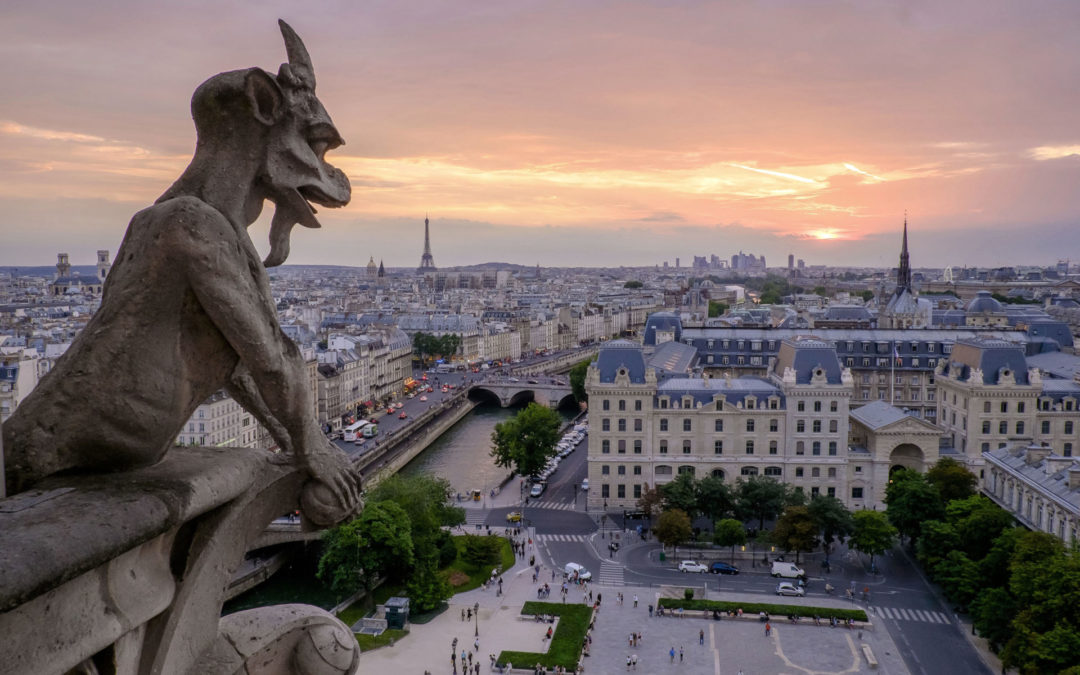It’s impossible not to fall in love with Paris. It’s a diverse and sophisticated city that attracts millions of travelers from all over the globe.
Paris is packed with things to do, from world-famous French cuisine to a dynamic fashion scene, gorgeous landmarks and monuments, to picturesque cafes. And don’t forget all the riveting museums and art galleries!
The City of Light has earned its well-deserved reputation, and no visitor should be concerned about finding themselves bored.
That said, it’s essential to adequately educate yourself about your destination before a trip.
This is something I have come to appreciate over my many years of curating unique once-in-a-lifetime trips for my clients.
If you’re visiting Paris for the first time, this blog post is a good starting point to help introduce you to the city. It’s also the first installment in my 3-Part Series on Paris.
Click here to read Part 2 and Part 3.
1. Discover the Gems of Paris

Paris would not be Paris without its celebrated monuments. The city is home to some of the most significant historical buildings in the world—all of which testify of the city’s long and rich past.
From the iconic Eiffel Tower to the majestic Arc de Triomphe and the towering Panthéon, there’s no doubt the enchanting French capital is a bonafide custodian of European culture.
Other great points of interest include the Place de la Concorde, Sacré-Cour, and Sainte-Chapelle, a 13th-century royal chapel located in the heart of Paris.
All these attract a lot of visitors but generally speaking, summertime and December are the crowdest months.
So expect to stand in line for quite some time when visiting the most famous monuments and landmarks.
Did you know that it is estimated that more than 250 million people have visited the Eiffel Tower since its completion in 1889!
Getting to the top can be quite an ordeal, starting with a long wait and then shuffling through security only to be crammed into an elevator with other visitors. To avoid all this, I suggest a private, behind-the-scenes tour.
2. Explore a Cornucopia of Museums

Boasting more than 150 museums, it’s possible to spend an entire trip (or a lifetime) exploring the art collections in Paris and still not be done!
For example, the Musée du Louvre, originally a royal palace, is the world’s largest museum. It’s home to the Mona Lisa and a massive collection of about 35,000 pieces of art.
Exploring the gigantic museum can be a daunting task, and it’s so easy to get overwhelmed and distracted.
If you want to enjoy all this museum has to offer, a tour with a knowledgeable private guide who can provide historical context and share unique insights will make all the difference in the world. Utilizing the professional services of a private guide is one of the perks of working with a travel specialist.
You can further immerse yourself in French culture at the renovated Picasso Museum and the new Fondation Louis Vuitton, not to mention dozens of small museums and galleries located all over the city.
For example, the Musée Rodin and Musíee Marmottan are quieter, less crowded museums that offer the perfect antidote to the Louvre’s overwhelming magnificence.
Such museums are generally devoted to specific artists (the Musée Picasso or the Musée Rodin) or genres (medieval art at the Cluny Museum or modern art at the Pompidou Center).
With so much variety, no visitor should leave Paris without exploring a museum or two or three.
3. Learn Some French

As you know, the official language of the country is French. The good news is that you don’t need to be fluent in French to communicate with Parisians. In the parts of the city that most visitors experience, the locals often will understand and speak to you in English.
Nevertheless, knowing the basics will make a huge difference. It will make it easier for you to get around and experience the culture of Paris when you are able to communicate with the local people. With technology, learning a new language or at least the basics has never been easier.
Spare a few minutes daily in the days leading to your trip to learn some greetings and a few useful phrases. A good starting point is learning the expressions you’ll need to understand the menu, order food, and ask for the bill. Je voudrais un verre de vin. Anyone?
If you have a little more time, you could even try out one of the numerous beginner-friendly French courses online. These are good tools for learning a new language because the material is presented in a structured way.
French pronunciation is never straightforward. So don’t let fear or embarrassment hold you back from striking conversations with the locals. Yes, your French will be corrected a few times, but overall most locals who do this are just trying to help.
Keep in mind that if a Parisian can speak English, they will most likely want to speak English with you. This is especially helpful in busy places like restaurants and attraction sites where communication has to be more efficient and fast-paced.
Even if you don’t manage to learn some French before your trip, that’s OK. Paris is a city of incredible hospitality, flavor, and beauty, even if you don’t know the language.
4. Navigate the 20 Districts of Paris

Paris is organized into 17 zones called Arrondissements. Initially, there were 20 Arrondissements, but in 2020 the central four arrondissements of Paris become one under the name Paris Centre.
These are urban administrative districts with their own town hall, mayors and other elected officials.
These should not be confused with Parisian Quartiers such as Le Marais or Saint-Germain-des-Prés, which are neighborhoods that have been around for centuries long before the administrative structure came into effect.
In fact, one Arrondissement usually includes several Paris Quartiers within its boundaries. Also, unlike Quartiers, the Arrondissements don’t have names. Instead, it’s just Paris 1, Paris 2, Paris 3 and so on.
If you look at a Paris Arrondissement Map, the 1st and the oldest Arrondissement of Paris is in the center of the city.
The rest of the Arrondissements are laid out in a clockwise spiral pattern starting from 1st Arrondissement all the way to the 20th Arrondissement.
What if you don’t have a map? Just look at the nearest street sign! In addition to telling you what street you’re on, the plaques also show the Arrondissement.
Even if the first four arrondissements are grouped together, the city’s postcodes have remained the same. The last two numbers of any Paris postcode indicate which Arrondissement that area is in.
These numbers make it easy to check the exact location of hotels and other facilities quickly.
Interestingly enough, each Arrondissement has its own character and charm. For example, many of the famous Parisian monuments and sights are located in Paris 1—ideal for visitors.
On the other hand, the 12th or 14th Arrondissements are mainly Paris residential areas, so they might not appeal to people visiting Paris for the first time.
5. Public Transportation: The Best Way to Get Around

If you want to enjoy and experience Paris in full, public transportation is the way to go!
To start off, Paris has a great, well-connected underground metro system. It’s generally safe and easy to use once you familiarize yourself with it a bit.
On top of that, all the must-see places in Paris usually have a metro station nearby.
There’s also the Réseau Express Régional (RER) suburban train line. The RER is faster than the Metro, but the stops are few and much further apart.
When using either, always make sure to check your destination carefully before getting on to confirm that the train you’re boarding goes to your stop.
Another fantastic way to explore the city is by taking the bus. With a total of 64 lines operating within the Parisian city limits, you can get just about anywhere the Metro will take you.
Also, this way, you can admire the views from the window on your way to your final destination.
I also highly recommend good old walking. This actually might be the best way to really savor the full ambiance of Parisian streets, shops, neighborhoods and magnificent historical buildings, and museums.
Want to move a little faster? You should try the Vélib’ Métropole system, a self-service bicycle rental service serving the French capital and surrounding area.
With a fleet of 20,000 bikes (a third of which are electric) and 1,400 rental stations spread across the region, riding a bicycle has become one of the more preferred ways of moving around Paris.
Paris also has a fleet of taxis and riverboats. If you do choose to take a taxi, always make sure it is equipped with a red and white “Taxi Parisien” sign on its rooftop and has a visible meter inside.
It can be unsafe, especially for solo women travelers, to accept a ride without verifying the driver’s credentials.
***
PLANNING A TRIP TO PARIS?
TRAVEL HACK: BE AWARE OF MAJOR FESTIVAL DATES
Parisians love their summer festivals. If you’re planning a trip to Paris, keep an eye out for major festival dates and plan accordingly. Here are the largest & most celebrated events.
Fête Nationale (Bastille Day): Every year on 14th July, the whole of France celebrates the storming of the Bastille in the only appropriate way: a massive party. The day itself begins with a military parade down the Champs Élysées and ends with fireworks in the evening. Viva la France!
The Paris l’Eté Festival (Paris Summer Festival) blends world-class talents & local artists. This event offers free dance & theatre performances from around the world, park concerts, and even a circus and a parade at monuments and Parisian squares. It’s usually held from 12th July – 3rd August.
Le Tour de France, the world’s premier long-distance bicycling race (2,162 miles), ends in Paris. Expect huge crowds at Place de la Concorde to see the winner flying past the finishing line on the Champs-Elysées. The Tour de France ends in Paris in the third week of July.
***
SO MUCH TO DO AND SEE IN PARIS. WHERE DO YOU GET STARTED?
Paris for first-timers can be overwhelming; there are so many things to see and do! And online research sometimes doesn’t help that much. It can even contribute to the overwhelm!
While the information out there is free and very helpful, nothing beats working with an experienced personal travel specialist. If you’ve been dreaming about visiting Paris but don’t have the time to research and plan your trip, drop me a line. I would love to help you curate the perfect Parisian vacation. Click here to request a consult with me.

